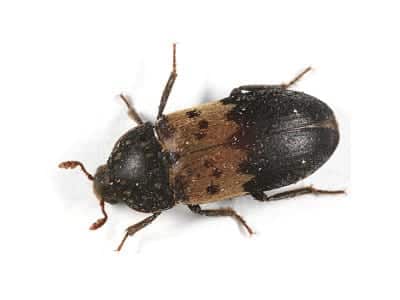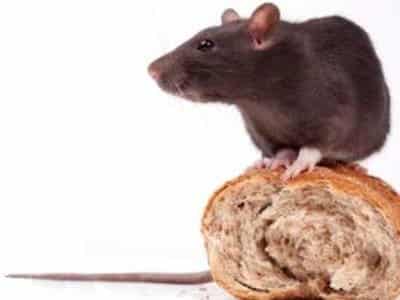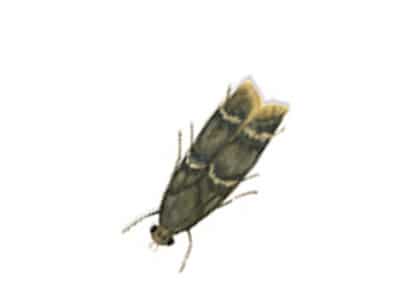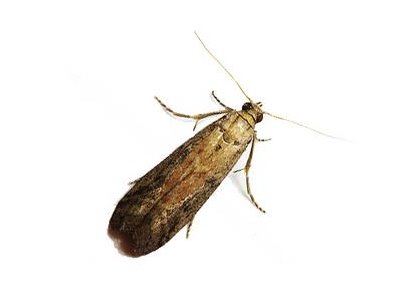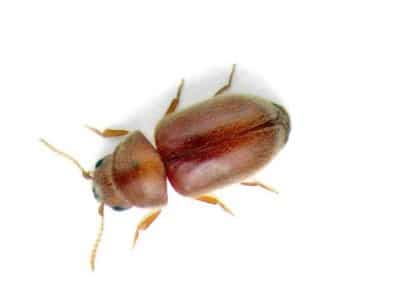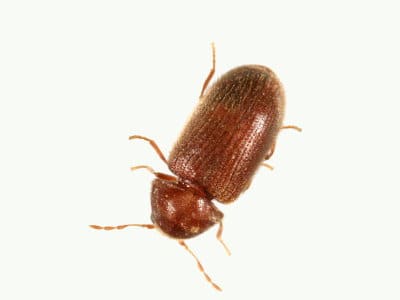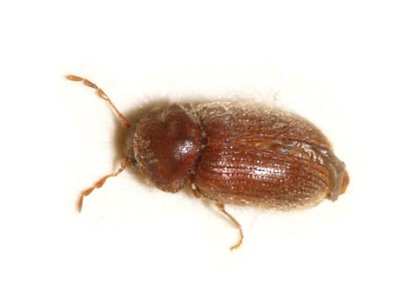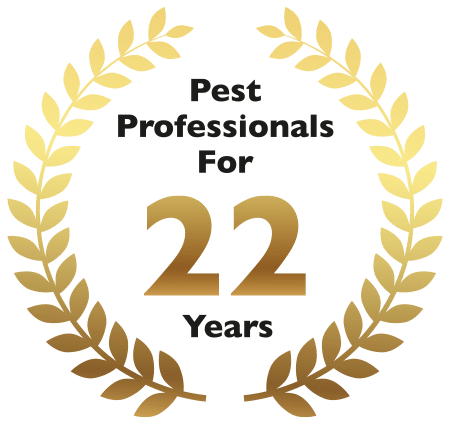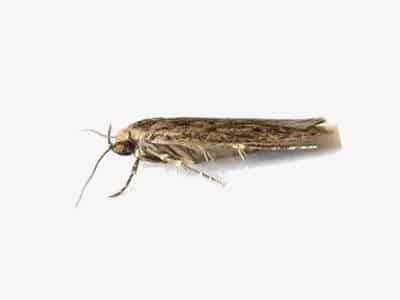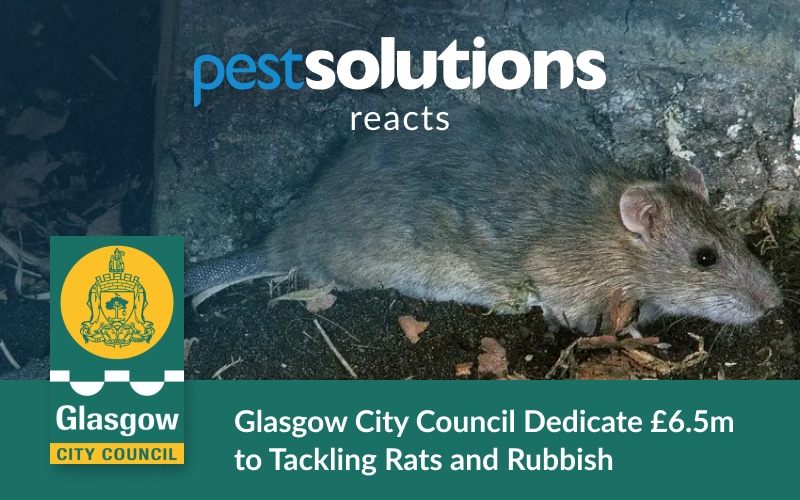About Larder Beetles
Larder beetles (Dermestes lardarius) are a species of insect belonging to the family Dermestidae. These small, oval-shaped beetles are known for their scavenging habits, often infesting stored food products and other organic materials. Larder beetles get their name from their historical association with larders, pantries and stored food products.
Pest Solutions are here to help with larder beetle problems. Get the details of your local Pest Solutions Branch here or call our national advice line on 0800 027 2555 to arrange a FREE survey or a service visit.
Identifying Larder Beetles
Adult larder beetles are usually 8-9mm in length. They have distinctive markings that make them relatively easy to identify. Their bodies are black with a broad, pale yellow or light-brown band running across their wings. This band is often marked with dark spots. Larder beetle larvae are elongated and covered in fine hairs, giving them a bristle-like appearance.
Signs of Larder Beetle Infestation
There are typical signs of larder beetle infestations that homeowners and business owners should be aware of. Finding adult larder beetles or larvae in and around stored food, pantry shelves, or other organic material is a clear sign of infestation.
Larvae feed on a wide range of food products, including grains, flour, cured meats, and dried fruits, which leads to irregular holes and damage in packaging. As larder beetle larvae grow, they shed their skins, leaving behind exoskeletons that can accumulate in infested areas. The larvae produce small, brown, pellet-like excrement, which can be found in and around infested materials.
The hide beetle undergoes a complete metamorphosis which includes 4 life cycle stages: Egg, Larva, Pupa and Adult.
It all begins with the adult female larder beetle laying eggs. These eggs are typically laid in hidden or protected locations near a suitable food source. Larder beetles are attracted to decaying animal or plant matter, and they lay their eggs close to these food sources.
The larvae of larder beetles are the most destructive stage of their lifecycle. When the eggs hatch, the larvae emerge and immediately start feeding on the nearby organic material. They are voracious eaters and can cause significant damage to stored food products and other organic matter.
After a period of feeding and growth, the larvae enter the pupal stage. During this stage, they transform into adult beetles. Pupation occurs within a cocoon-like structure, and it can take a variable amount of time depending on environmental conditions, such as temperature and food availability.
Once the transformation is complete, adult larder beetles emerge from their pupal cases. Adult beetles are less destructive to stored food and tend to feed on pollen, nectar, and other plant-based materials. Adults will then reproduce, laying new eggs and continuing the cycle.
Larder Beetle Behaviour
Larder beetles are opportunistic scavengers. They are attracted to decaying organic matter, such as animal carcasses, dried plant materials, and stored food products. This scavenging behaviour is the basis of their feeding habits.
Larvae are the most damaging stage of the larder beetle life cycle. They are voracious eaters and can consume a wide range of organic materials. They actively feed on stored food products, animal remains, and other organic matter, often leaving behind irregular holes and damage in the infested materials. Adult larder beetles feed on nectar, pollen, and other plant-based materials. They are less destructive to stored food products than their larval counterparts.
Adult larder beetles are capable of flight, allowing them to disperse and locate new sources of food. They are attracted to light, which can sometimes lead them into homes through open windows or doors.
Larder beetles are phototropic, meaning they are attracted to light. This behaviour can sometimes bring them into homes, where they may become a nuisance when attracted to artificial light sources. These insects are nocturnal, primarily active during the night, which can make it more challenging to spot and control them during the daytime.
Risk of Larder Beetle Infestation
Larder beetles are a common household pest in the UK. Larder beetles are notorious for infesting and damaging stored food products. Their larvae are voracious eaters and can bore through packaging, causing contamination of food items. Infested food becomes inedible and must be discarded, leading to financial losses for homeowners and businesses. At home, infestations will often begin in hard to reach or neglected areas where spilled food gathers.
In addition to infesting food items, larder beetles can also infest structural components of buildings, particularly soft woods. They may be found in wall voids, attics, and other hidden areas, potentially causing damage to the structural integrity of a building over time.
The presence of larder beetles can lead to health concerns. Their larvae may carry bacteria and allergens, which can be transmitted to humans through contaminated food. This can potentially cause allergic reactions or foodborne illnesses.
Significance of Controlling Larder Beetle
Larder beetles infest and damage stored food products, making them unsuitable for consumption. Controlling larder beetles helps protect the quality and safety of food supplies in homes, restaurants, and food storage facilities.
Larder beetle infestations can result in financial losses due to the destruction of food products. Effective control measures can reduce the economic impact of infestations by preserving the value of stored goods.
Larder beetles can also be agricultural pests, infesting stored crops and animal feed. This can lead to substantial economic losses for farmers and agribusinesses.
Controlling Larder Beetle Infestations
If a larder beetle infestation is discovered, discard any infested food items and materials. Be sure to seal them in airtight bags or containers to prevent further contamination.
Infested areas should be thoroughly cleaned in detail, paying attention to cracks and crevices where beetles and larvae may hide. Vacuuming is an effective way to remove larvae, exoskeletons, and faecal pellets.
For severe or persistent infestations, a suitable insecticide may be required.
Preventing Larder Beetle Infestations
A proactive approach is required to prevent larder beetle infestations at home. This involves goods hygiene and housekeeping practices to make your home less attractive for these insects.
Keep cupboards, pantries and stores areas clean to remove food sources for larder beetles. Spilled food and food debris in these areas are easy pickings for scavenging larder beetles.
Regularly inspect and clean out your food storage areas, disposing of old, expired, or unused food products. Larder beetles are attracted to decaying organic matter.
High risk foods such as grains, cereal, pasta, and flour should be stored in suitable airtight containers. This prevents larder beetles from accessing and infesting your food.
Checking void spaces such as lofts or storage areas for any signs of potential infestations will help identify any potential issues. Early detection can prevent infestations from becoming severe. However, if these beetles are already present, it is too late for prevention.
DIY Pest Control
DIY control methods are often not as effective as professional pest control services, especially for extensive or persistent infestations. Larder beetles can hide in hard-to-reach areas, and their eggs, larvae, and pupae can be challenging to eliminate without professional expertise and tools.
DIY methods often address immediate concerns but may not provide long-term solutions. Amateur use products may kill adult beetles and some larvae, but they may not address hidden infestations or eggs that are yet to hatch. This can result in a resurgence of the problem.
When to Call a Professional
For severe or persistent larder beetle infestations, it’s generally advisable to seek professional pest control services. Professionals have the expertise and tools to effectively manage the issue, ensure complete eradication, and minimize risks to health and safety. Additionally, can provide ongoing monitoring and preventive measures to prevent future infestations.
Call Pest Solutions to Get Rid of That Beetle Today!
Pest Solutions have local Branches across Scotland, England, Wales and Northern Ireland. Our expert local techs are at hand to attend today. Call now to get an experienced Pest technician visit and get that Pest problem under control swiftly.
Get the details of your local Pest Solutions Branch here or call our national advice line on 0800 027 2555 to arrange a FREE survey or a service visit.
Find out more about how to get rid of Beetles






